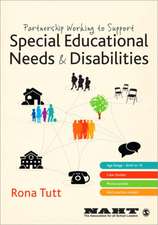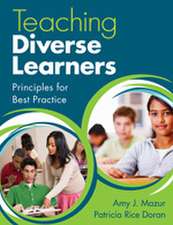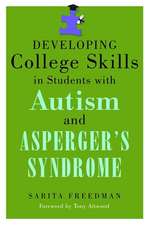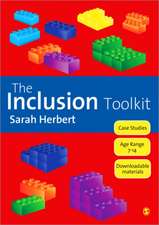Inclusion Strategies for Secondary Classrooms: Keys for Struggling Learners
Editat de Mildred C. Goreen Limba Engleză Paperback – 7 iun 2010
- Addresses the reauthorization of IDEA 2004 and the full impact of NCLB on special education
- Highlights how the strategies in this book can be incorporated in all levels of RTI
- Includes expanded discussion of Universal Design for Learning
Preț: 275.40 lei
Nou
Puncte Express: 413
Preț estimativ în valută:
52.70€ • 57.42$ • 44.41£
52.70€ • 57.42$ • 44.41£
Carte disponibilă
Livrare economică 02-16 aprilie
Livrare express 18-22 martie pentru 38.76 lei
Preluare comenzi: 021 569.72.76
Specificații
ISBN-13: 9781412975445
ISBN-10: 1412975441
Pagini: 248
Dimensiuni: 216 x 279 x 15 mm
Greutate: 0.61 kg
Ediția:Second Edition
Editura: SAGE Publications
Colecția Corwin
Locul publicării:Thousand Oaks, United States
ISBN-10: 1412975441
Pagini: 248
Dimensiuni: 216 x 279 x 15 mm
Greutate: 0.61 kg
Ediția:Second Edition
Editura: SAGE Publications
Colecția Corwin
Locul publicării:Thousand Oaks, United States
Recenzii
"This updated text provides a wide range of instructional tools that are cleverly introduced, well-referenced, and clearly presented. It provides an informative and practical introduction to preservice teachers who are preparing to work with older students. At the same time, it offers an excellent refresher for practicing teachers by providing some new and fresh approaches that can be incorporated into everyday inclusive classrooms. I expect this book to become bookmarked and dog-eared from both initial use and subsequent reference by serious educators."
Cuprins
Preface
Acknowledgments
About the Author
1. The Letters Behind the Book
No Child Left Behind
Resopnse to Intervention
Universal Design for Learning
The Purpose of this Book
A Note About People First Language
2. The Locks on the Doors to Learning
The Locks on the Doors
The Input Locks
The Information Processing/Retention Locks
The Affective Locks
The Output Lock
The Sum Total of the Locks
3. Keys to the Effectiveness of the Inclusion Strategies
Dual Coding Theory and Tri-Coding of Information
4. Ensuring Students Understand Instructions
Key 1: Gain Students' Attention with Attentional Cues
Key 2: Providing Written and Oral Instructions
Key 3: Repeat Instructions
Key 4: Chunking Instructions
Key 5: Tell-Backs and Show-Mes
5. Teaching the Concepts and Vocabulary of Our Disciplines Strategies
Key 6: Taxonomic Fee
Key 7: Semantic Feature Analysis Matrix
Key 8: Compare and Contrast Vocabulary Mix
Key 9: Typology
Key 10: Word Analysis Diagram
Key 11: Semantic Map
Key 12: Quick Sketching a Definition
Key 13: Total Physical Response and Vocabulary Drama
Key 14: Keyword Mmemonic Strategy
Key 15: Teaching Greek and Latin Morphemes
Key 16: Vocabulary Word Card Ring
Key 17: Vocabulary Word Wall
Key 18: Learning Games
Key 19: Peer Tutoring
6. Teaching Devices for Increasing Student Learning From Lectures
Key 20: Simply Slowing Down
Key 21: Pause Procedure
Key 22: Cueing Critical Points
Key 23: Explicitly Teaching the Big Ideas
Key 24: Providing an Advance Organizer
Key 25: Soliciting Students' Examples
Key 26: Providing a Plethora of Examples
Key 27: Providing Nonexamples
Key 28: Teaching CSA/CRA
Key 29: Role Playing Difficult Content
7. Increasing Learning by Using Note Taking Strategies
Key 30: Teaching Abbreviations
Key 31: Teach Summarizing
Key 32: Partial Graphic Organizer Notes
Key 33: Guided Notes
Key 34: Strategic Notes
Key 35: Brick and Mortar Notes
Key 36: Three-Column Perzonalized Notes
Key 37: Newspaper Notes
8. Promoting Student Learning From the Textbook
Key 38: Using GOs to Make Relationships Explicit
Key 39: Pre-Teaching Vocabulary
Key 40: Explicitly Teaching Text Structure
Key 41: Accessible Digital Textbooks
9. Increasing Learning by Using Textbook Guides
Key 42: Main Idea Text Structure Study Guide
Key 43: List Text Structure Study Guide
Key 44: Order Text Structure Study Guide
Key 45: Compare and Contrast Text Structure Study Guide
Key 46: Cause and Effect Text Structure Study Guide
Key 47: Problem Solution Study Guide
Key 48: Analogy Study Guide
10. Promoting Factual Mastery Through Mnemonic Devices
Key 49: Keyword Mmemonics with Narrative Chains
Key 50: Musical Mmemonisc
11. Improving Higher-Order Thinking Skills
Key 51: Storyboards Type 1
Key 52: Storyboards Type 2
Key 53: Flowcharts
Key 54: Venn-Euler Diagram
Key 55: Reasoning by Metaphor and Analogy
Key 56: Compare and Contrast Matrix
Key 57: Campfire Metaphor for Cause and Effect
Key 58: Evaluation by Elimination by Aspects Matric
Key 59: Evaluation by Addition Matrix
12. Improving the Quality of Expository Writing
Key 60: Teaching Summarizing
Key 61: Teaching Text Structure
Key 62: Writing Frames
Key 63: Using Rubrics
Key 64: Data Revival Chart
Key 65: Adapted Evaluation Matrices
Key 66: Graphic Organizers for Expository Writing
13. Future Keys
Future Key #1: fMRI-Supported Learning Strategies
Future Key #2: Virtual Reality
Future Key #3: Podcasting
Future Key #4: Videogame-Based Learning
Future Key#5: Videoconference Tutoring
The Last Word
References
Index
Acknowledgments
About the Author
1. The Letters Behind the Book
No Child Left Behind
Resopnse to Intervention
Universal Design for Learning
The Purpose of this Book
A Note About People First Language
2. The Locks on the Doors to Learning
The Locks on the Doors
The Input Locks
The Information Processing/Retention Locks
The Affective Locks
The Output Lock
The Sum Total of the Locks
3. Keys to the Effectiveness of the Inclusion Strategies
Dual Coding Theory and Tri-Coding of Information
4. Ensuring Students Understand Instructions
Key 1: Gain Students' Attention with Attentional Cues
Key 2: Providing Written and Oral Instructions
Key 3: Repeat Instructions
Key 4: Chunking Instructions
Key 5: Tell-Backs and Show-Mes
5. Teaching the Concepts and Vocabulary of Our Disciplines Strategies
Key 6: Taxonomic Fee
Key 7: Semantic Feature Analysis Matrix
Key 8: Compare and Contrast Vocabulary Mix
Key 9: Typology
Key 10: Word Analysis Diagram
Key 11: Semantic Map
Key 12: Quick Sketching a Definition
Key 13: Total Physical Response and Vocabulary Drama
Key 14: Keyword Mmemonic Strategy
Key 15: Teaching Greek and Latin Morphemes
Key 16: Vocabulary Word Card Ring
Key 17: Vocabulary Word Wall
Key 18: Learning Games
Key 19: Peer Tutoring
6. Teaching Devices for Increasing Student Learning From Lectures
Key 20: Simply Slowing Down
Key 21: Pause Procedure
Key 22: Cueing Critical Points
Key 23: Explicitly Teaching the Big Ideas
Key 24: Providing an Advance Organizer
Key 25: Soliciting Students' Examples
Key 26: Providing a Plethora of Examples
Key 27: Providing Nonexamples
Key 28: Teaching CSA/CRA
Key 29: Role Playing Difficult Content
7. Increasing Learning by Using Note Taking Strategies
Key 30: Teaching Abbreviations
Key 31: Teach Summarizing
Key 32: Partial Graphic Organizer Notes
Key 33: Guided Notes
Key 34: Strategic Notes
Key 35: Brick and Mortar Notes
Key 36: Three-Column Perzonalized Notes
Key 37: Newspaper Notes
8. Promoting Student Learning From the Textbook
Key 38: Using GOs to Make Relationships Explicit
Key 39: Pre-Teaching Vocabulary
Key 40: Explicitly Teaching Text Structure
Key 41: Accessible Digital Textbooks
9. Increasing Learning by Using Textbook Guides
Key 42: Main Idea Text Structure Study Guide
Key 43: List Text Structure Study Guide
Key 44: Order Text Structure Study Guide
Key 45: Compare and Contrast Text Structure Study Guide
Key 46: Cause and Effect Text Structure Study Guide
Key 47: Problem Solution Study Guide
Key 48: Analogy Study Guide
10. Promoting Factual Mastery Through Mnemonic Devices
Key 49: Keyword Mmemonics with Narrative Chains
Key 50: Musical Mmemonisc
11. Improving Higher-Order Thinking Skills
Key 51: Storyboards Type 1
Key 52: Storyboards Type 2
Key 53: Flowcharts
Key 54: Venn-Euler Diagram
Key 55: Reasoning by Metaphor and Analogy
Key 56: Compare and Contrast Matrix
Key 57: Campfire Metaphor for Cause and Effect
Key 58: Evaluation by Elimination by Aspects Matric
Key 59: Evaluation by Addition Matrix
12. Improving the Quality of Expository Writing
Key 60: Teaching Summarizing
Key 61: Teaching Text Structure
Key 62: Writing Frames
Key 63: Using Rubrics
Key 64: Data Revival Chart
Key 65: Adapted Evaluation Matrices
Key 66: Graphic Organizers for Expository Writing
13. Future Keys
Future Key #1: fMRI-Supported Learning Strategies
Future Key #2: Virtual Reality
Future Key #3: Podcasting
Future Key #4: Videogame-Based Learning
Future Key#5: Videoconference Tutoring
The Last Word
References
Index
Descriere
This updated resource provides key strategies to unlock learning barriers for struggling adolescents and examines how the strategies can be applied within Response to Intervention initiatives.











